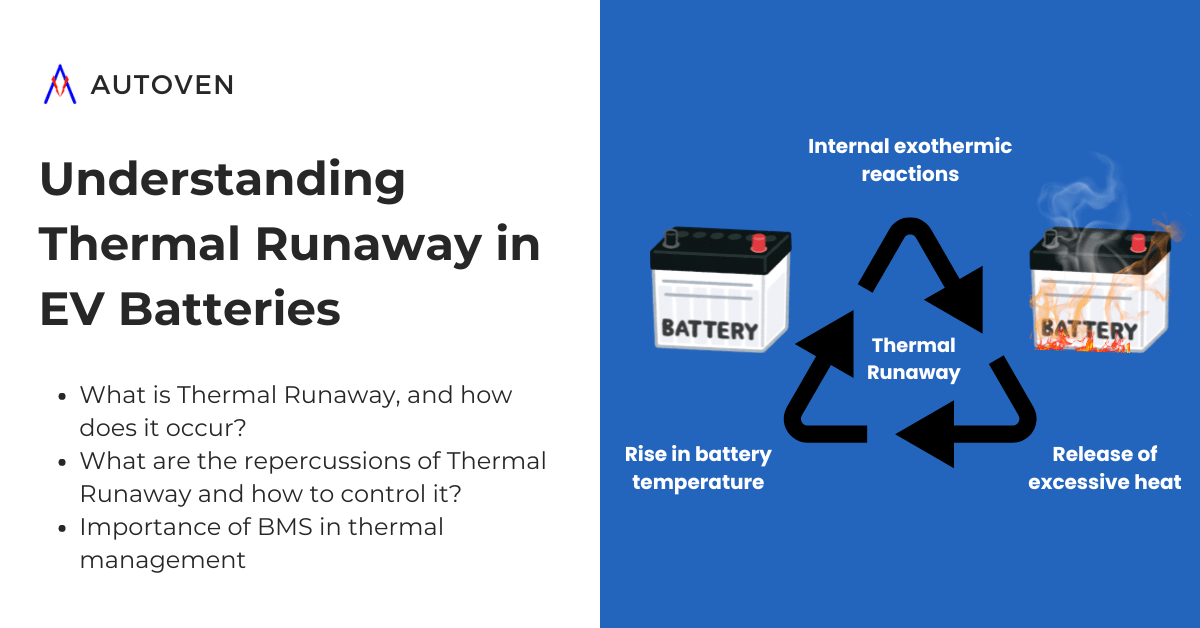Effectively protecting batteries has been a pressing concern for EV OEMs. Let us, therefore, understand thermal runaway, an event that leads to burnt batteries.
Introduction
Electric vehicles (EVs) are becoming the future of transportation. At the heart of every EV is its battery, the most integral block, providing the power necessary for operation. However, with the increasing use of high-capacity batteries, safety concerns are rising, especially regarding thermal runaway.
What is Thermal Runaway?
Thermal runaway is a dangerous and often catastrophic failure mode in batteries. It occurs when a battery cell enters a self-heating state, leading to an uncontrollable rise in temperature.
When a battery undergoes thermal runaway, a rapid temperature rise ignites exothermic reactions within the battery. These reactions release heat, further accelerating the process. As the temperature rises, more energy is released, creating a vicious cycle of increasing heat and pressure. This phenomenon triggers a domino effect, which causes adjacent cells to enter thermal runaway.
The onset of these reactions is caused by a rise in battery temperature due to internal issues like electrical faults, thermal failure, electrochemical imbalance, etc., or external issues like mechanical faults and environmental ordeals.
How Does Thermal Runaway Occur?
Thermal runaway can start due to several factors:
Overcharging: Charging a battery beyond its recommended voltage can cause excessive heat. Overcharging forces the battery to store more energy than it can handle, increasing internal pressure and temperature.
Internal Short Circuits: Manufacturing defects or damage can cause short circuits inside the battery cells. These short circuits create pathways for current to flow uncontrollably, generating intense heat.
External Heat Sources: High ambient temperatures or external heat sources can raise the battery’s temperature. Prolonged exposure to heat, such as from direct sunlight, can initiate thermal runaway.
Physical Damage: Impact or crushing of the battery can lead to internal damage and short circuits. Accidents or improper handling during manufacturing, transportation, or usage can cause such damage.
Degradation: Over time, the battery’s internal resistance can increase, leading to heat generation during normal operation. Repeated charging and discharging cycles often accelerate this degradation.
When these conditions occur, the battery’s internal temperature can rise rapidly. Once the battery reaches a critical temperature, exothermic reactions can occur. These reactions release additional heat, further increasing the battery’s temperature. This feedback loop can result in the battery catching fire or exploding.
Repercussions of Thermal Runaway
The repercussions of thermal runaway are severe and multi-faceted:
Safety Hazards: Thermal runaway can cause fires and explosions, posing significant safety risks to passengers and first responders. The intense heat and flames can quickly spread, endangering lives and property.
Vehicle Damage: Fires resulting from thermal runaway can destroy the vehicle and cause damage to nearby property. The intense heat can melt and deform the vehicle’s structure, rendering it unusable.
Environmental Impact: Burning batteries release toxic fumes and pollutants, harming the environment. These emissions include harmful chemicals and heavy metals that can contaminate air, water, and soil.
Reputation Damage: Incidents of thermal runaway can damage the reputation of EV manufacturers and hinder consumer trust in EV technology. News of battery fires can lead to negative publicity and reduced sales.
Financial Losses: Manufacturers can incur substantial costs associated with recalls, repairs, and legal liabilities. Addressing thermal runaway incidents often involves expensive investigations, settlements, and regulatory fines.
Given these potential consequences, preventing thermal runaway is crucial for EVs’ safe and reliable operation.
Controlling Thermal Runaway
To effectively control and prevent thermal runaway, manufacturers and engineers employ several strategies:
Advanced Materials: Using materials with high thermal stability and low flammability can reduce the risk of thermal runaway. Innovations in electrolyte formulations and separator materials are critical in this regard.
Improved Cell Design: Enhancing the design of battery cells to minimize internal short circuits and improve heat dissipation can help prevent thermal runaway. This includes optimizing the placement of current collectors and electrodes.
Active Cooling Systems: Implementing active cooling systems that respond rapidly to temperature changes helps maintain battery safety. These systems can include liquid cooling, forced air cooling, or phase change materials.
Thermal Barriers: Incorporating thermal barriers between cells can help contain the heat generated during thermal runaway and prevent it from spreading to adjacent cells.
Enhanced BMS Algorithms: It is crucial to develop sophisticated algorithms for the BMS that can predict and respond to thermal events. These algorithms can analyze data from thermal sensors and adjust cooling mechanisms in real-time. They publish allowable current limits and have dynamic cut-offs based on temperature, SoC, SoH, and other relevant parameters.
Redundancy and Fail-safes: Incorporating redundancy and fail-safes in both hardware and software components ensures that even if one system fails, others can take over to prevent thermal runaway.
Regular Maintenance and Monitoring: Regular maintenance and health checks on battery systems can help identify potential issues before they lead to thermal runaway. IoT-based monitoring and detection of abnormal trends compared to similar vehicles in similar ambient conditions allows for the early detection of abnormalities.
Education and Training: It is essential to educate consumers and technicians about proper battery handling, charging, and maintenance practices. Proper usage and handling can significantly reduce the risk of thermal runaway.
Importance of Battery Management Systems (BMS) in Thermal Management
A Battery Management System (BMS) ensures battery safety and health. It continuously monitors and controls various battery pack parameters, including voltage, current, temperature, and state of charge. Here’s how the BMS plays a crucial role in thermal management:
Temperature Monitoring: The BMS has thermal sensors that continuously monitor the battery’s temperature. These sensors provide real-time data, allowing the BMS to detect abnormal temperature rises early. The BMS can proactively prevent overheating by tracking temperature variations within the battery pack.
Cell Balancing: One of the key functions of a BMS is to balance the charge across all cells in the battery pack. Cell voltage imbalance can lead to uneven heating, where certain cells become hotter than others. The BMS ensures uniform charge distribution, minimizing the risk of localized overheating that could trigger thermal runaway.
Overcharge/Discharge Protection: Overcharging and deep discharging are significant risk factors for battery overheating. The BMS prevents overcharging by cutting off the charge once the battery reaches its maximum voltage. Similarly, it prevents deep discharging, which can cause the battery to heat up during recharging. This protective feature maintains the battery within safe operating limits.
Fault Detection and Isolation: Faulty cells can generate excessive heat and pose a serious risk of thermal runaway. The BMS identifies and isolates these cells from the rest of the battery pack. By removing or bypassing faulty cells, the BMS prevents the heat from spreading and causing further damage.
Practical Applications of BMS in Thermal Management
The BMS monitors and controls thermal conditions and integrates with these advanced thermal management techniques. Here’s how the BMS works with various thermal management strategies:
Integration with Cooling Systems: The BMS can control liquid and forced air cooling systems based on real-time temperature data. When the sensors detect rising temperatures, the BMS activates the cooling system to dissipate heat and maintain optimal battery temperature.
Adaptive Thermal Management: The BMS can adjust its thermal management strategies based on the vehicle’s operating conditions. For instance, during high-performance driving, the BMS may enhance cooling efforts, while during low-demand periods, it may optimize energy usage by reducing cooling activity.
Predictive Diagnostics: By continuously monitoring battery health, the BMS can predict when maintenance is needed to prevent thermal issues. This predictive approach ensures that potential problems are addressed before they escalate into critical failures.
Energy Efficiency: The BMS optimizes energy usage for thermal management, balancing cooling needs with overall vehicle efficiency. This balance is crucial for extending the vehicle’s range and improving its overall performance.
Conclusion
Thermal runaway is a critical issue in EV batteries that can have severe repercussions. Understanding the causes and effects of thermal runaway is essential for improving EV safety. Advanced thermal management techniques and robust Battery Management Systems are vital in preventing thermal runaway. By continuously monitoring and managing battery conditions, these systems ensure the battery’s health and safety, enhancing the reliability of electric vehicles. As the adoption of EVs continues to grow, the focus on preventing thermal runaway will remain a top priority for manufacturers and consumers alike.
By staying informed and investing in cutting-edge battery technologies, we can drive the future of transportation toward a safer, more sustainable horizon. The integration of advanced BMS will be crucial in achieving this goal. These systems prevent thermal runaway and enhance overall battery performance and longevity. For EV manufacturers, prioritizing battery health and thermal management is essential in building trust and ensuring the long-term success of electric vehicles.



